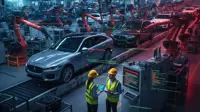International space station's urine recycler finally repaired
29 Nov 2008
Astronauts at the International space station, a 15-nation joint partnership led by NASA, which operates the space station, were finally able to repair the urine recycler system thus enabling it o expand its six member crew next year.
The new $154-million urine recycler system which was shutting down prematurely due to thermal interference between a speed sensor and the centrifuge and excess vibration, failed to work after repeated attempts by Astronauts to repair it with the aid of directions from ground controllers.
Last week, Astronauts had undertaken one of the longest and hardest spacewalks of their mission when they made a second failed attempt in a seven hour repair work at the centrifuge in the distillation assembly of a hardware designed to convert urine into potable water. (See: Astronauts stuck with repairs of urine recycler at International Space Station)
In the fourth and final attempt, Astronauts took six hours outside the space station and added and tightened bolts on the 10 foot urine recycler system, which had been shutting down frequently.
After some anxious moments and a late night spent with minor trouble shootings, the recycler was restarted and made back-to-back five-hour test runs, which then operated continuously without the earlier power surges that had shut off the processor and completed a full four hour purification cycle for the first time since it arrived on the ISS on 16 November.
The astronauts who were asked to postpone their departure this week from the ISS by a day to try and make a final attempt to get the urine recycler working paid off and now the flight shuttle Endeavour will depart on Friday with samples of water reclaimed from combinations of urine, perspiration and other humidity collected from the station's air supply.
NASA will conduct at least three months of recovery operations and the fluid samples will be tested in NASA laboratories to ascertain whether the urine recycler meets the standards required by NASA before declaring the water safe for drinking. Additional samples will be returned on the next shuttle flight in February.
Once it works as per the standard required by NASA then the urine recycler will be able to recycle the station's 6.8 tonnes of waste water produced each year.
Astronauts also conducted another test at the station this week to check the massive jammed starboard side gear designed to turn the station's right side solar arrays so they always face the sun and maximize power production.
They carried out repairs to the solar power network and cleaned and lubricated rotational mechanisms that turn the solar panels on opposite ends of the station.
After 12 days at the ISS, the space shuttle Endeavour and its crew of seven left the international space station, but stayed near the outpost for several hours longer than planned in order to avoid coming too close to debris from an old Russian satellite.
Two Americans and a Russian crew have stayed back and the Endeavour is scheduled to return to Earth on Sunday.






.webp)















